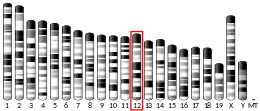CENPO
Centromere protein O is a protein that in humans is encoded by the CENPO gene.[5][6][7] CENPO is involved in cell proliferation and cell cycle progression and has been shown to be down-regulated in trisomic neurospheres a mouse model of Down Syndrome, resulting in reduced numbers of neural progenitors and neuroblasts and a severe reduction in numbers of neurons produced. [8]
References
- GRCh38: Ensembl release 89: ENSG00000138092 - Ensembl, May 2017
- GRCm38: Ensembl release 89: ENSMUSG00000020652 - Ensembl, May 2017
- "Human PubMed Reference:". National Center for Biotechnology Information, U.S. National Library of Medicine.
- "Mouse PubMed Reference:". National Center for Biotechnology Information, U.S. National Library of Medicine.
- Okada M, Cheeseman IM, Hori T, Okawa K, McLeod IX, Yates JR 3rd, Desai A, Fukagawa T (May 2006). "The CENP-H-I complex is required for the efficient incorporation of newly synthesized CENP-A into centromeres". Nat Cell Biol. 8 (5): 446–57. doi:10.1038/ncb1396. PMID 16622420. S2CID 26974412.
- Foltz DR, Jansen LE, Black BE, Bailey AO, Yates JR 3rd, Cleveland DW (May 2006). "The human CENP-A centromeric nucleosome-associated complex". Nat Cell Biol. 8 (5): 458–69. doi:10.1038/ncb1397. PMID 16622419. S2CID 205286556.
- "Entrez Gene: CENPO centromere protein O".
- Hewitt, Chelsee A.; Ling, King-Hwa; Merson, Tobias D.; Simpson, Ken M.; Ritchie, Matthew E.; King, Sarah L.; Pritchard, Melanie A.; Smyth, Gordon K.; Thomas, Tim (2010-07-16). "Gene Network Disruptions and Neurogenesis Defects in the Adult Ts1Cje Mouse Model of Down Syndrome". PLOS ONE. 5 (7): e11561. doi:10.1371/journal.pone.0011561. ISSN 1932-6203. PMC 2905390. PMID 20661276.
External links
- Human CENPO genome location and CENPO gene details page in the UCSC Genome Browser.
Further reading
- Strausberg RL, Feingold EA, Grouse LH, et al. (2003). "Generation and initial analysis of more than 15,000 full-length human and mouse cDNA sequences". Proc. Natl. Acad. Sci. U.S.A. 99 (26): 16899–903. doi:10.1073/pnas.242603899. PMC 139241. PMID 12477932.
- Ota T, Suzuki Y, Nishikawa T, et al. (2004). "Complete sequencing and characterization of 21,243 full-length human cDNAs". Nat. Genet. 36 (1): 40–5. doi:10.1038/ng1285. PMID 14702039.
- Obuse C, Yang H, Nozaki N, et al. (2004). "Proteomics analysis of the centromere complex from HeLa interphase cells: UV-damaged DNA binding protein 1 (DDB-1) is a component of the CEN-complex, while BMI-1 is transiently co-localized with the centromeric region in interphase". Genes Cells. 9 (2): 105–20. doi:10.1111/j.1365-2443.2004.00705.x. PMID 15009096. S2CID 21813024.
- Gerhard DS, Wagner L, Feingold EA, et al. (2004). "The status, quality, and expansion of the NIH full-length cDNA project: the Mammalian Gene Collection (MGC)". Genome Res. 14 (10B): 2121–7. doi:10.1101/gr.2596504. PMC 528928. PMID 15489334.
- Hillier LW, Graves TA, Fulton RS, et al. (2005). "Generation and annotation of the DNA sequences of human chromosomes 2 and 4". Nature. 434 (7034): 724–31. doi:10.1038/nature03466. PMID 15815621.
- Rual JF, Venkatesan K, Hao T, et al. (2005). "Towards a proteome-scale map of the human protein-protein interaction network". Nature. 437 (7062): 1173–8. doi:10.1038/nature04209. PMID 16189514. S2CID 4427026.
- Izuta H, Ikeno M, Suzuki N, et al. (2006). "Comprehensive analysis of the ICEN (Interphase Centromere Complex) components enriched in the CENP-A chromatin of human cells". Genes Cells. 11 (6): 673–84. doi:10.1111/j.1365-2443.2006.00969.x. PMID 16716197. S2CID 45931410.
This article is issued from Wikipedia. The text is licensed under Creative Commons - Attribution - Sharealike. Additional terms may apply for the media files.




